Septimius Severus › The Arch of Septimius Severus, Rome » Ancient origins
Articles and Definitions › Contents
- Septimius Severus › Who Was
- The Arch of Septimius Severus, Rome › Antique Origins
Ancient civilizations › Historical and archaeological sites
Septimius Severus › Who Was
Definition and Origins
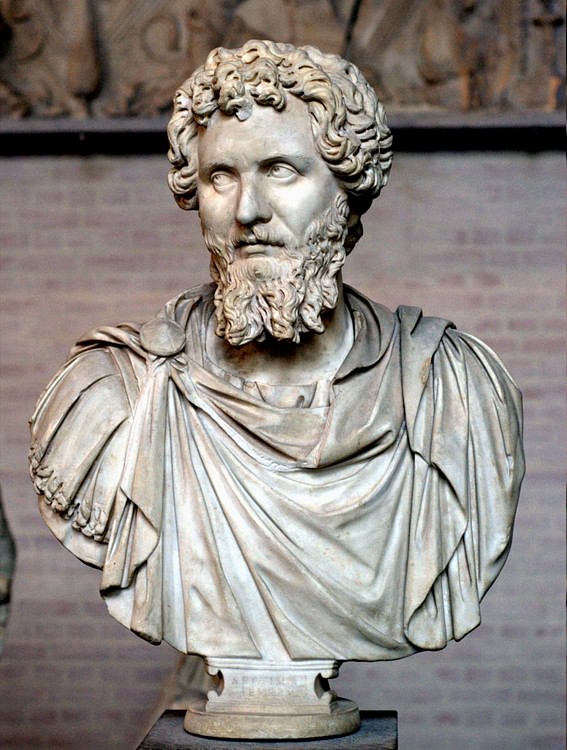
Lucius Septimius Severus was Roman emperor from April 193 to February 211 CE. He was of Libyan descent from Lepcis Magna and came from a locally prominent Punic family who had a history of rising to senatorial as well as consular status
His first visit to Rome was around 163 CE during the reign of Marcus Aurelius and Lucius Verus. He was protected by his cousin Caius Septimius Severus and entered the Roman Senate in 170 CE. When his cousin went to Africa as a proconsul around 173-174 CE, he chose L. Septimius Severus to be his legatus. L. Septimius married Paccia Marciana around 175 CE who had Punic origins like him; however, she died ten years later. When he was governor of Gaul and he lived in Lugdunum (Lyon), he married Julia Domna from Emesa ( Syria ) around 187 CE. She was descended from a family of great priests of Eliogabal.
Septimius' rise to emperor began with the murder of the dissolute ruler Commodus on the last day of 192 CE. Commodus' immediate successor, the well-respected if elderly Pertinax, was quickly made emperor afterwards. Pertinax's actions as emperor, however, enraged members of the Praetorian Guard who disliked his efforts to enforce stricter discipline. Moreover, the inability of Pertinax to meet the Guard's demands for back pay led to their revolt which ended in the emperor's assassination. The Praetorian Guard then cynically proceeded to auction off the imperial throne to the highest bidder with the person willing to pay the most being promised the support of the Praetorian Guard and therefore the imperial throne. A rich and prominent senator, M. Didius Julianus, perhaps as a joke at first, proceeded to outbid all others at the auction and thus was proclaimed emperor by the Praetorians solely for the reason that he promised to pay them the most money. This affair caused considerable resentment among the population at Rome who openly denounced Julianus and the way in which he acquired the throne. Word of such unrest at Rome spread to the provinces and led to the emergence of three possible candidates to challenge Julianus' rule.
AFTER SECURING THE LOYALTY OF THE SIXTEEN LEGIONS OF THE RHINE AND DANUBE TO HIS CAUSE, SEPTIMIUS MARCHED INTO ITALY AND WAS RECOGNIZED BY THE SENATE AS EMPEROR.
The first candidate was Clodius Albinus, governor of Britain. The second was Pescennius Niger, governor of Syria, and the third was, of course, Septimius Severus who governed the province of Pannonia Superior on the Danube frontier. All three governors emerged as possible candidates mainly because each of them held provinces that were defended by three legions apiece. Not only did this give each governor a powerful military base of three legions but also ensured that the provinces adjacent to them would more often than not join in their cause if they decided to rise up and make a bid for imperial power.Both Albinus and Niger did so. Septimius, in making his claim, had an edge over these two men. He had an advantage not only in terms of propaganda (Septimius had served with Pertinax previously and successfully portrayed himself as the 'avenger of Pertinax,' even adopting the slain emperor's name) but also in terms of location as Pannonia was the closest of these provinces to Italy and Rome. To prevent a possible clash with Clodius Albinus in Britain, he secured Albinus' support mainly by promising him the title of Caesar and thus a place in the imperial succession should Septimius be successful. After securing the loyalty of the sixteen legions of the Rhine and Danube to his cause, Septimius marched into Italy and, 60 miles outside of Rome, was recognized by the Senate as emperor. Julianus was executed, and Septimius was welcomed into Rome on 9 June 193 CE. With his accession, the year 193 CE is known as 'The Year of Five Emperors.'
Septimius quickly dissolved the existing Praetorian Guard and replaced it with a much larger bodyguard recruited from the Danubian legions under his command. To strengthen his rule in Italy, he also raised three new legions (I-III Parthica), based the second of these not far from Rome at Alba, and increased the city of Rome's number of vigils, urban cohorts, and other units, greatly enlarging Rome's overall garrison.
Having now secured Rome (and, for the moment, Albinus' loyalty in the west), Septimius now organized a campaign to march to the eastern provinces to eliminate his rival Niger. Severan forces handed out successive defeats to Niger, driving his forces out of Thrace, then defeating him at Cyzicus and Nicaea in Asia Minor in 193 CE, and ultimately defeating him at Issus in 194 CE. While in the East, Severus turned his forces against the Parthian vassals who had backed Niger in his claims. He quickly subdued the kingdoms of Osroene and Adiabene, taking the titles Parthicus Arabicus and Parthicus Adiabenicus to commemorate these victories. To solidify his reputation and attempt to link his new dynasty with that of the Antonines, he declared himself the son of the now deified former emperor Marcus Aurelius and brother of the deified Commodus. Moreover, he conferred upon his eldest son M. Aurelius Antoninus (later the emperor Caracalla ) the title of Caesar. This last move led him into direct conflict with his erstwhile ally Clodius Albinus who was initially given this title in return for his loyalty. Realizing that Severus intended to discard him, Albinus rebelled and crossed with his legions into Gaul. Severus hurried west to meet Albinus in battle at Lugdunum and defeated him in a bloody and hard fought battle in February 197 CE. After defeating Albinus, Severus was now the sole emperor of the Roman Empire.

Arch of Septimius Severus, Rome
In the summer of 197 CE, Severus once again travelled to the eastern provinces where the Parthian Empire had taken advantage of his absence to besiege Nisibis in Roman occupied Mesopotamia. After breaking the Parthian siege there, he proceeded to march down the Euphrates attacking and sacking the Parthian cities of Seleucia, Babylon, and ultimately the Parthian capital of Ctesiphon. He would have liked to have continued his campaigns deeper into the Parthian Empire, although Dio states that he was prevented from doing so due to a lack of military intelligence and knowledge that the Romans had of the Parthian heartland. Septimius then turned against the fortress of Hatra in Iraq, but failed to take it after two attempted sieges.After coming to a face-saving agreement with Hatra, Septimius declared victory in the East, taking the title of Parthicus Maximus (indeed, the Senate voted him a Triumphal Arch in the Roman Forum which still stands today). It was during this time that he organized the lands of northern Mesopotamia, captured from the Parthians, into the new province of Roman Mesopotamia which Dio states Severus hoped would serve as a 'bulwark for Syria' against any future Parthian invasions (how effective this policy was in the years after Severus' reign is a matter which is open to debate).
Severus then travelled to Egypt in 199 CE, reorganizing the province. After returning to Syria for a year's stay (end of 200 to beginning of 202 CE), Severus finally travelled back to Rome in summer 202 CE to celebrate his decennalia with a victory game as well as giving his son Antoninus in marriage to the daughter of his confidant, the Praetorian Prefect Plautianus (who was later murdered thanks to the intrigues of Antoninus). In autumn of that same year, Severus travelled to his homeland of Africa, touring (and greatly patronising) Severus' home town of Lepcis Magna, as well as Utica and Carthage. At Lepcis Magna, he conducted an energetic program of monument building, providing colonnaded streets, a new forum, a basilica, and a new harbor for his hometown. He also used this time to crush the desert tribes (most notably the Garamantes) who had been harassing Rome's African frontiers. Severus expanded and re-fortified the African frontier, even expanding Rome's presence into the Sahara thus curtailing the raiding activities of these border tribes who could no longer attack Roman lands with impunity and then escape back into the desert.
Severus then returned to Italy in 203 CE where he stayed until 208 CE, holding the Secular games in 204 CE. With the murder of his Praetorian Prefect Plautianus, Severus replaced him with the jurist Papinian. His patronage of this new prefect as well as the jurists Ulpian and Paul made the Severan era a golden one for Roman jurisprudence.
In 208 CE, small scale fighting on the frontier of Roman Britain gave Severus the excuse to launch a campaign there which would last until his death in 211 CE. With this campaign, Severus was hoping for a chance to achieve military glory. Moreover, he brought with him his sons Antoninus and Geta in the hopes of providing them with some administrative and military experience necessary for holding the imperial power (until this point, the two sons had spent their time violently quarrelling with each other as well as behaving like libertines carousing at Rome's less reputable establishments).
In 208 CE, small scale fighting on the frontier of Roman Britain gave Severus the excuse to launch a campaign there which would last until his death in 211 CE. With this campaign, Severus was hoping for a chance to achieve military glory. Moreover, he brought with him his sons Antoninus and Geta in the hopes of providing them with some administrative and military experience necessary for holding the imperial power (until this point, the two sons had spent their time violently quarrelling with each other as well as behaving like libertines carousing at Rome's less reputable establishments).

Roman Emperor Septimius Severus
Severus' intentions in Britain were almost certainly to subdue the entire island and bring it under Roman rule completely. In order to do this, Severus completely repaired and renovated many of the forts along Hadrian ’s Wall with the intention of using the Wall as a base from which to launch a campaign to conquer the north of the island of Britain. Leaving Geta south (supposedly leaving him responsible for the civil administration of Britain south of the wall), Severus and his son Antoninus campaigned in the north, especially in what is now Scotland. The course of the campaign was one that was mixed for the Romans: the native Caledonian tribes did not meet the Romans in open battle and engaged in guerrilla tactics against them and caused the Romans to suffer heavy casualties. By 210 CE, however, the northern tribes sued for peace, and Severus used this opportunity to build a new advance base at Carpow on the Tay for future campaigning. He also took the title Britannicus for himself and his sons to commemorate this victory. This success was short-lived, however, as the tribes soon rose up in revolt. By this time (211 CE), Severus could not continue his campaigns against them. He was a long-time sufferer of gout which appears to have taken a toll on him: He died at Eburacum (York) on 4 February 211 CE.
Severus' reign witnessed the implementation of reforms in both the provinces and the military which had long term consequences. After the defeat of his rivals, Severus resolved to not have another take power in the fashion that he did.Consequently, he divided the three legion provinces of Pannonia and Syria to discourage future governors to rise up in revolt (Pannonia was divided into the new provinces of Pannonia Superior and Pannonia Inferior; Syria was divided into Syria Coele and Syria Phoenice). Britain was also divided into two provinces ( Britannia Superior and Britannia Inferior), although it is debated whether or not Severus or his son and successor Caracalla did this.
Severus is also noted for his reforms of the army. Not only did he greatly increase the size of the army, in order to ensure its loyalty he also raised the annual pay of the soldiers from 300 to 500 denarii (many would have seen this pay rise as overdue, as the last raise in soldiers' salaries was granted by the emperor Domitian in 84 CE). Severus, to pay for these raises, had to debase the silver coinage. It seems that the long term effects this may have had on inflation were minimal, although Severus set a precedent for future emperors to continuously debase the coinage in order to pay for the army. The historians Dio and Herodian criticized Severus for these pay rises, mainly because it put more financial pressure on the civilian population to maintain a larger army. Moreover, Severus ended the ban on marriage which had existed in the Roman army, giving soldiers the right to take wives. This measure has been argued by some to be a positive reform as it gave legal rights to the wives of soldiers who before the ban had no legal recourse as their relationships were informal and not legally binding. So concerned was Severus with the loyalty of the army that, on his deathbed, he is said to have advised his two sons to 'Be good to one another, enrich the soldiers, and damn the rest.'
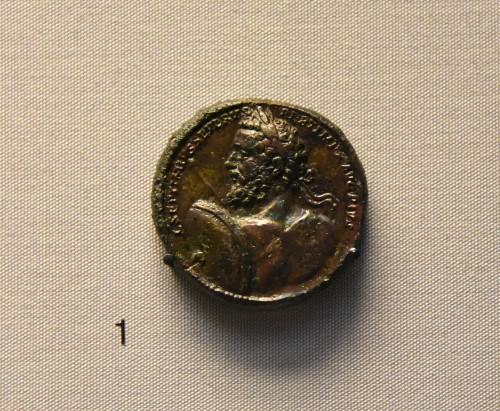
Medallion of Emperor Septimius Severus
Severus could be ruthless towards his enemies. When he defeated Niger in the East, not only did he attack many of the cities in that region which supported his rival, he is noted for taking metropolitan status away from the city of Antioch (Niger's base of operations), and giving it to its chief rival, the city of Laodicaea. After defeating Albinus at the battle of Lugdunum, Severus released his wrath on the Roman Senate, many of its members having given either muted or open support to Albinus.Severus, after declaring his intentions to purge the Senate in a speech to that body in 197 CE, proceeded to execute 29 senators of that body for having supported his rival (many other non-senatorial supporters of Albinus met the same fate).
Despite emerging victorious from a period of civil war and bringing stability to the empire, Severus' sense of accomplishment may have been mixed. His last words, according to various historians, seem to imply that he felt he may have left his work unfinished. Aurelius Victor reported that Severus, on his deathbed, despairingly declared 'I have been all things, and it has profited nothing.' Dio, who knew Severus personally, wrote that, as the emperor expired, he gasped 'Come, give it to me, if we have anything to do!'
The Arch of Septimius Severus, Rome › Antique Origins
Ancient Civilizations
The Arch of Septimius Severus, erected in 203 CE, stands in Rome and commemorates the Roman victories over the Parthians in the final decade of the 2nd century CE. The triple triumphal arch was one of the most richly decorated of its type and even today, although badly damaged, it stands in the Forum Romanum as a lasting and imposing monument to Roman vanity.
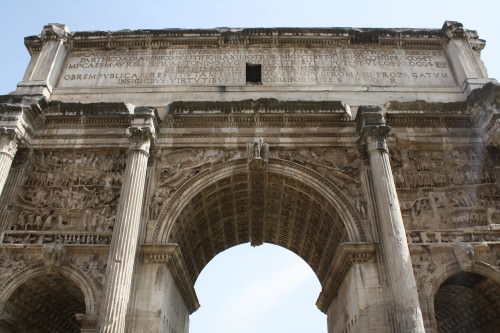
Arch of Septimius Severus, Rome
The arch stands on the Via Sacra in the Forum Romanum of Rome and has the three arches typical of later Roman triumphal arches. The larger central archway was used for traffic, whilst the two outer arches were closed off by steps. In terms of construction materials the core and foundations are of tavertine whilst, the whole is faced with Proconnesian marble, a feature of which is its grey and white bands. The eight composite columns, four on each façade, are of the same marble type.
It was possible to climb the arch via an inner staircase within the south pier, although the entrance was actually 5 m above ground level for security. There was both a walkway above the second cornice and access to the roof through the hollow attic.
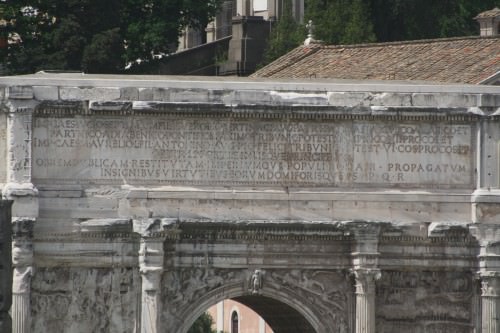
Inscription, Arch of Septimius Severus, Rome
INSCRIPTION
The inscription on the attic, originally with gilded bronze lettering, is a dedication to Septimius Severus and his two sons Caracalla and Geta who 'restored the Republic and expanded the dominion of the Roman people'. This refers to the successful campaigns against the Parthians in modern Iran when Septimius Severus took the city of Ctesiphon (197 CE) and created the new Roman province of Mesopotamia (199 CE). Interestingly, the inscription was changed following Geta's murder by his brother Caracalla in 212 CE, perhaps due to a guilty conscience, with the addition of P. Septimo L. fil. Getae nobliss Caesari or 'most noble Caesar Geta'.
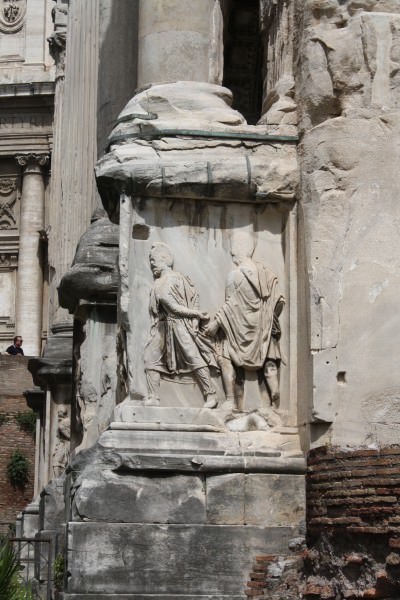
Detail, Arch of Septimius Severus, Rome
DECORATIVE SCULPTURE
The arch was richly decorated with sculpture which depicted scenes from the military campaigns in Parthia, the seasons, various deities, and victories. The style of the sculpture is similar to that on the column of Marcus Aurelius c. 180 CE but, unfortunately, it is in a poor state of preservation and many scenes are barely discernible today. Above the central arch on both façades are winged victories who each carry trophies. The arch has the typical central keystone of this genre of architectural monument which here represents Mars, the Roman god of war. The smaller arches also have keystones which are carved to represent Bacchus and Hercules - gods which Septimius Severus held in particular esteem. The lower arches also carry figures, this time river gods. Above each of the small arches is a frieze which depicts a triumphal procession where booty and prisoners are being shown off. The column plinths each have relief sculpture showing Roman soldiers with captured Parthians.
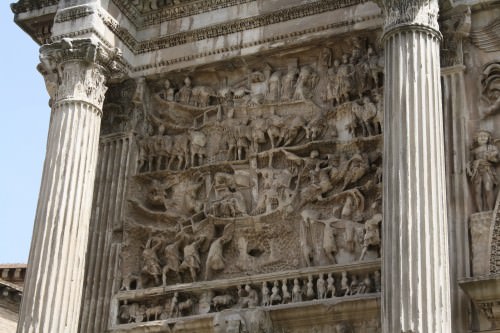
Relief Panel, Arch of Septimius Severus, Rome
The most impressive sculpture is found on four huge panels - two on each façade - which show scenes from the military campaigns in Parthia. The left panel on the Forum side shows the army leaving their camp, a battle, Septimius Severus speaking before his troops, and the liberation of Nisibis. The right panel shows siege machines attacking the city of Edessa, a group of Parthians surrendering to Septimius Severus, a war council within a fortified camp, and the launch of a new campaign. On the Capitoline side the left panel depicts the city of Seleucia under attack, its eventual fall, and defeated Parthians. The right panel shows the siege of Ctesiphon with its ultimate defeat and Septimius Severus speaking in front of his victorious army.
On top of the structure, as indicated in coins of the period, there would once have been a six-horse chariot in gilded bronze on which rode a statue of Septimius Severus. The emperor was also originally flanked by his two sons on horseback, possibly rendered in silver. Trophies and garlands in bronze would also once have adorned the plain surfaces around the inscription on the façades.

Arch of Septimius Severus, Rome
LATER HISTORY
The monument, like many other buildings from antiquity, suffered in later times, particularly in the Middle Ages when it was converted into a fortress, towers were added, and the structure was incorporated into surrounding buildings. Within the central passage a sculptor or stonemason even had a shop and the profiles he carved into the inner walls are still visible today.Likewise, the smaller archways were used for commerce right up until the 19th century CE. The worst damage to the structure, however, stems from the inferior quality of the original material and possibly also workmanship when it was originally built.Several deep cracks in the marble, vertical fissures in the columns, and the breaking off of pieces of sculpture can be attributed to the workmen not paying proper attention to the natural bedding of the marble. The sculptures have also suffered severe damage due to weathering and environmental pollution.
LICENSE:
Article based on information obtained from these sources:with permission from the Website Ancient History Encyclopedia
Content is available under License Creative Commons: Attribution-NonCommercial-ShareAlike 3.0 Unported. CC-BY-NC-SA License